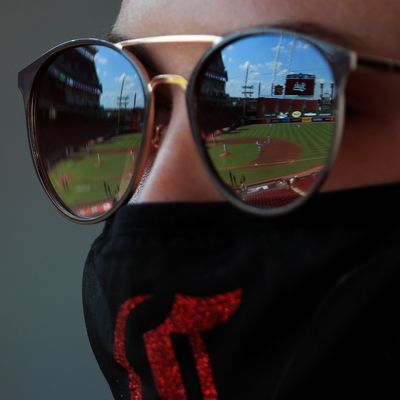
For all the talk of fake crowd noise at sporting events around the world, pumped in to create the temporary illusion that there are fans in the stands — and that we are are not living in the daily hellscape of this pandemic and our tragically hapless attempt to contain it — it’s not the sounds inside a ballpark that are disorienting and upsetting in the year 2020, but the ones outside it.
Inside Cincinnati’s Great American Ballpark, where I watched (along with a few dozen fellow masked media members, two lonely mascots named Mr. Redlegs and Rosie Red, and a few guys trying to sneak a peek while walking across the Taylor Southgate Bridge out in center field) the Cincinnati Reds play their second game against the Detroit Tigers on Saturday night, baseball continued its attempts to salvage what it can from this COVID-ball season. It was strange and surreal to watch a Major League Baseball game in an empty stadium, with all the Jumbotrons and musical cues and gaudy advertisements for local car dealerships trying to act like everything is exactly as it’s supposed to be while players do their absolute best to overcome decades of muscle memory so that they may refrain from spitting. Baseball is still baseball, however. In whatever shape you might attempt to twist and wrangle it into, the game itself always ends up looking like baseball, up to a point, anyway.
But there is a certain sound that surrounds and envelopes a baseball game, and it is a sound that has little to do with the crack of a bat or the pop of a glove. It is the sound of clamor, of activity, of people. The best baseball stadiums, like Cincinnati’s, are in heavily trafficked areas, often downtown, and a baseball game being played isn’t so much a sporting event as it is a civic call to action. It is an announcement that things are happening. Bars fill up hours before a first pitch. Kids pose with their parents in front of the stadium. Middle-aged white men wearing Guy Fieri hats and shirts that don’t really fit them drink domestic beer out of plastic cups while they weave and wobble through the streets. It’s a whole scene. A city stretches and stirs when a baseball game is going on, particularly on a warm-but-pleasant summer weekend like this one, and what you hear isn’t so much sports as it is a downtown coming to life. Whether you’re in the stadium or not, whether you even know or care that there’s a game going on at all, there’s a low-level hum, an electric murmur, that is unmistakable.
What is perhaps most remarkable about a baseball game in which no fans are allowed to go inside the stadium is how much their absence extinguishes everything outside of it. This is counterintuitive. After all, whether or not there are people inside the stadium shouldn’t matter to the people outside the stadium: They’re outside the stadium. Bars and restaurants are open for indoor and outdoor dining in downtown Cincinnati, cases in Hamilton County are actually down (though the Reds announced their first positive player test on Saturday), and Governor Mike DeWine’s recent statewide mask order appeared to be widely accepted and complied with.
But there was no stir outside the stadium during the opening weekend of the long-awaited season. Five minutes before first pitch, an outdoor table at the Holy Grail Tavern — which, located directly across the street from the Great American Ballpark, is as fine a place for an establishment called the “Holy Grail Tavern” as you will find in the entire state of Ohio — was readily available. (“There wasn’t anyone here yesterday either,” a woman in a cut-off T-shirt selling frozen drinks at the bar told me. She wore both a small Reds mask that kept falling off her face and a perpetually bored expression. “And that was Opening Day.”) The Reds Team Store, operated within the ballpark complex but open to the public, was entirely empty, full of souvenirs that hadn’t been updated since last year. A local busker played Matchbox 20’s “3 a.m.” to no one in particular, and his attempts to gather cheap crowd heat by tossing in a “Go Reds!” at the end of every song went consistently unanswered. (I will confess it was still as close to a live music show as I’ve been to in months; I dropped a dollar in his mostly empty bucket.)
I have been to Cincinnati Reds games before, and this bustle of hubbub around the park on game day is one of its signature charms. The local merchants tried to recreate that atmosphere around the park. But it was only the husk, with nothing in the middle. It felt a little like one of those fake suburban towns with mannequins and cul-de-sacs they built outside nuclear testing facilities in the ’50s. Everything is dressed up to look the same, but it’s all eerie, vacant and sad. And with that perpetual whiff of impending doom.
This has reportedly been the case around baseball stadiums all throughout the country, even famously raucous Wrigleyville, and it of course makes sense: It doesn’t exactly feel like a fun or responsible time to be out in public brandishing your Guy Fieri hat and root, root, rooting for your team. And to be clear, it is definitely weird inside the stadium too. Crowd noise is pumped in to make the experience feel more normal for television viewers at home, but in the park itself, it’s sporadically deployed and relatively quiet: The sound of the “crowd” rarely rises above, say, the din of the press box air conditioner. That droning of the air conditioner accentuated the lack of natural noise and perspective, leading to an experience that’s not entirely unlike watching the taping of a television show you’ve been seeing through your screen for years: Everything is both too big and too small. You are constantly reminded that you are, in fact, watching a television show, one that has been constructed and presented entirely for people who are not in attendance. The bleachers are covered with ads for Tide, Charmin, and Kroger; the scoreboard implores viewers at home to Make Some Noise and the angles cut in tight and close on players’ faces who are miles away from us in the upper deck. (Though you can hear them yell “Fuck!” when they strike out.) The broadcasts of these games have been experimental, with cardboard cutout and virtual fans inserted into the telecast, and on the whole, they’ve been effective. You can watch a whole game on television and, if you get yourself in the right headspace and mental zone, only occasionally be reminded that anything is unusual at all. Which is of course the point.
But having no fans in the stands isn’t just uncanny. It robs you of context. In the first game of the season on Thursday night at Nationals Park in Washington, D.C., minutes after Dr. Anthony Fauci’s socially distanced, from-the-plate ceremonial first pitch, Yankees outfielder Giancarlo Stanton — a former MVP and superstar, and one of the highest paid and most visible players in the sport who nevertheless, because of his contract and regular injuries, is a constant target of Yankees fans — launched a monster home run off three-time Cy Young Award winner Max Scherzer. It was a triumphant shot, from a player who was so hurt he only played 14 games last year — a glorious, textbook moonshot that was basically the platonic ideal of what you’d hope to see announce baseball’s return, during a nationally televised, massively promoted event that ended up being the highest-rated regular-season baseball game in nearly a decade. It was the sort of home run that should go down forever in baseball history — the COVID equivalent of Mike Piazza’s famously tear-jerking home run for the Mets in the first game back after September 11. But it won’t. It barely registered. I haven’t heard anyone talking about it all. And that’s because without fans to react to the moment, it felt antiseptic, even perfunctory — an impressive physical achievement but an empty emotional one. It felt like pulling off a hard-fought victory in a video game that you are playing by yourself. You look around for people to say, “Holy shit, did you see that?” But there’s no one there.
Whether baseball will be able to pull off this trick-shot of a season remains an open question, though the game has a momentum all its own. If you are able to shrug off a positive COVID test from the best position player on the defending World Series champion team just a few hours before they are about to play in front of Dr. Fauci and the entire world (as the Nationals and MLB did Thursday with superstar outfielder Juan Soto), there might not be much you can’t shrug off. But it is worth constantly remembering that this is a trick-shot: MLB trying to salvage what it can of 2020 and hoping for brighter days, and a normal schedule with normal fans and a normal game environment, in 2021.
This season will go down in history as unlike any in baseball history, and for good reason. Attending a baseball game in 2020, whether you’re inside or outside the stadium, isn’t really like attending a baseball game at all. If you find yourself envious of those who are able to set foot inside the stadium, you shouldn’t be. The best way to experience baseball right now turns out to be the best thing you can do for you and your country and the greater good and public health of your fellow human beings: Stay inside and watch it at home. It might feel a little uncanny and unnerving on television, but trust me, it is even more so in person. That might be the most 2020 thing of all: The simulacrum produced for television feels drastically more real than the real thing. The best place to pretend, for a few hours anyway, that baseball can be a sign that life can be normal again — turns out to be as far from the ballpark as possible.






























